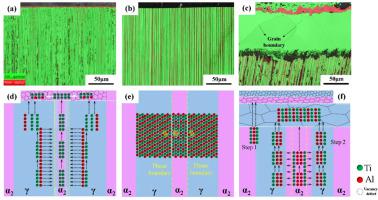当前位置:
X-MOL 学术
›
J. Mater. Sci. Technol.
›
论文详情
Our official English website, www.x-mol.net, welcomes your feedback! (Note: you will need to create a separate account there.)
Regulating phase ratios and mechanical properties of polysynthetic twinned TiAl single crystals via annealing
Journal of Materials Science & Technology ( IF 11.2 ) Pub Date : 2024-06-22 , DOI: 10.1016/j.jmst.2024.05.063 L.W. Kong , Z.B. Xing , F.R. Chen , Q.Q. Yin , L. Pang , X. Liu , Y. Shu , P. Li , Z.X. Qi , G. Chen , Y.J. Tian
Journal of Materials Science & Technology ( IF 11.2 ) Pub Date : 2024-06-22 , DOI: 10.1016/j.jmst.2024.05.063 L.W. Kong , Z.B. Xing , F.R. Chen , Q.Q. Yin , L. Pang , X. Liu , Y. Shu , P. Li , Z.X. Qi , G. Chen , Y.J. Tian

|
Polysynthetic twinned (PST) TiAl single crystal specifically refers to a fully lamellar TiAl single crystal with parallel phase interfaces and twin interfaces grown by directional solidification. In this paper, PST single crystals with different phase ratios are obtained by annealing at specific temperatures and holding times. The results show that the diffusion rates of Ti and Al elements at various temperatures directly trigger and propel the surface recrystallization and variation in the internal phase ratio. When the temperature is lower than 1448 K, the diffusion rate of Ti is obviously higher than that of Al, which causes one dense α recrystallized layer to form on the surface of TiAl single crystals. Meanwhile, as more Ti elements migrate to the surface, the α phase ratio inside the TiAl single crystal thereby decreases. When the temperature exceeds 1448 K, the diffusion rate of Al gradually reverses to exceed that of Ti, which forms the surface sandwiched recrystallization dominated by γ phase and simultaneously increases α phase ratio inside the TiAl single crystal. The variation in the two-phase ratio directly induces a significant change in the lamellae thickness, which exhibits different tensile behaviors of PST-TiAl single crystal. When the α phase content is less than 20 %, wider γ lamellae make it easier for dislocations to be activated within its lamellae and continuously move across the γ/α interfaces, thereby obtaining better tensile plasticity. As the α phase content exceeds 30 %, finer γ lamellae inhibit the dislocation initiation, resulting in the fracture occurrence of TiAl single crystal before yielding. No matter how the phase ratio changes, the crack preferentially initiates within α lamellae. However, the crack propagation follows different paths based on various γ lamella thicknesses. The fracture mode of PST-TiAl single crystal also changes from shear fracture along slip bands within the γ lamella to brittle fracture along the planes within α lamella.
中文翻译:

通过退火调节多合成孪晶 TiAl 单晶的相比和力学性能
多合成孪晶(PST)TiAl单晶特指通过定向凝固生长的具有平行相界面和孪晶界面的全层状TiAl单晶。本文通过在特定温度和保温时间下退火得到不同相比的PST单晶。结果表明,不同温度下Ti、Al元素的扩散速率直接引发和推动表面再结晶和内部相比的变化。当温度低于1448 K时,Ti的扩散速率明显高于Al的扩散速率,导致TiAl单晶表面形成一层致密的α再结晶层。同时,随着更多的Ti元素迁移到表面,TiAl单晶内部的α相比例因而降低。当温度超过1448 K时,Al的扩散速率逐渐逆转,超过Ti的扩散速率,形成以γ相为主的表面夹层再结晶,同时TiAl单晶内部α相比例增加。两相比的变化直接引起片层厚度的显着变化,从而表现出PST-TiAl单晶不同的拉伸行为。当α相含量小于20%时,较宽的γ片层使其片层内的位错更容易被激活并持续穿过γ/α界面,从而获得更好的拉伸塑性。当α相含量超过30%时,更细小的γ片层抑制位错萌生,导致TiAl单晶在屈服前发生断裂。无论相比如何变化,裂纹优先在α片晶内萌生。 然而,根据不同的 γ 片层厚度,裂纹扩展遵循不同的路径。 PST-TiAl单晶的断裂模式也从沿γ片层内滑移带的剪切断裂转变为沿α片层内平面的脆性断裂。
更新日期:2024-06-22
中文翻译:

通过退火调节多合成孪晶 TiAl 单晶的相比和力学性能
多合成孪晶(PST)TiAl单晶特指通过定向凝固生长的具有平行相界面和孪晶界面的全层状TiAl单晶。本文通过在特定温度和保温时间下退火得到不同相比的PST单晶。结果表明,不同温度下Ti、Al元素的扩散速率直接引发和推动表面再结晶和内部相比的变化。当温度低于1448 K时,Ti的扩散速率明显高于Al的扩散速率,导致TiAl单晶表面形成一层致密的α再结晶层。同时,随着更多的Ti元素迁移到表面,TiAl单晶内部的α相比例因而降低。当温度超过1448 K时,Al的扩散速率逐渐逆转,超过Ti的扩散速率,形成以γ相为主的表面夹层再结晶,同时TiAl单晶内部α相比例增加。两相比的变化直接引起片层厚度的显着变化,从而表现出PST-TiAl单晶不同的拉伸行为。当α相含量小于20%时,较宽的γ片层使其片层内的位错更容易被激活并持续穿过γ/α界面,从而获得更好的拉伸塑性。当α相含量超过30%时,更细小的γ片层抑制位错萌生,导致TiAl单晶在屈服前发生断裂。无论相比如何变化,裂纹优先在α片晶内萌生。 然而,根据不同的 γ 片层厚度,裂纹扩展遵循不同的路径。 PST-TiAl单晶的断裂模式也从沿γ片层内滑移带的剪切断裂转变为沿α片层内平面的脆性断裂。











































 京公网安备 11010802027423号
京公网安备 11010802027423号